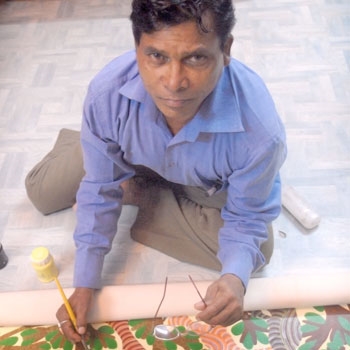Narmada Prasad Tekam
Narmada Prasad Tekam, who is in his 30s, weaves his paintings from the interrelationships among animals, birds and trees. His art does not invoke an idyllic past so much as it proposes fables of mutuality. In Tekam’s paintings, the gestures of war and the gestures of peace are difficult to tell apart. Peacocks, tigers and birds coexist, wary but accommodating. He presents deer and boars at play or in mock combat, their fur replaced by scalloped scales. Elsewhere, Tekam focuses on a dance or duel between a boar and a bird: incandescent against a teal field, these are not animals but actors in a shamanic drama. More amusingly, a regal serpent that has encircled a bird and is about to eat it, is distracted from its meal by a gaggle of pesky birds.
Tekam, like many of his colleagues, is devoted to the Tree of Life: this axis mundi is by turns alive with songbirds, heavy with houses in place of fruit, and transformed into an abacus of human heads, a Speaking Tree from the legends. Like many of his colleagues, also, Tekam is fascinated by stags whose antlers grow into trees, flower into forests. This image recalls to mind the Hungarian poet Ferenc Juhász’ celebrated poem, ‘The Boy Changed into a Stag Clamours at the Gate of Secrets’. A not wholly fortuitous association: Juhász attended the World Poetry Festival held at Bharat Bhavan in 1989, and his poem had a profound effect on many who read and heard it.
Tekam, like many of his colleagues, is devoted to the Tree of Life: this axis mundi is by turns alive with songbirds, heavy with houses in place of fruit, and transformed into an abacus of human heads, a Speaking Tree from the legends. Like many of his colleagues, also, Tekam is fascinated by stags whose antlers grow into trees, flower into forests. This image recalls to mind the Hungarian poet Ferenc Juhász’ celebrated poem, ‘The Boy Changed into a Stag Clamours at the Gate of Secrets’. A not wholly fortuitous association: Juhász attended the World Poetry Festival held at Bharat Bhavan in 1989, and his poem had a profound effect on many who read and heard it.
